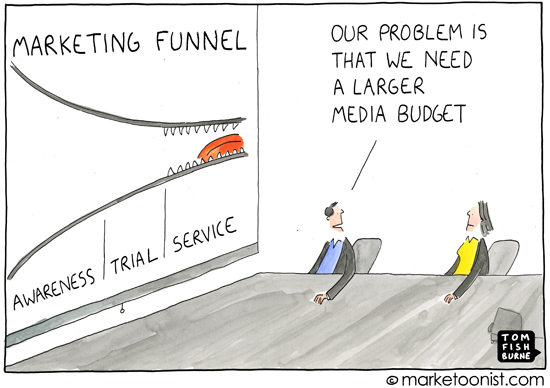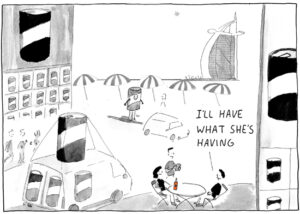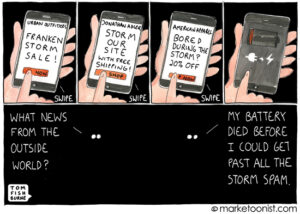The marketing funnel (sometimes called the purchase funnel or customer funnel) maps a consumer’s journey toward the purchase of a product or service. Marketers spend a lot of time thinking about the stages of that journey and how to maximize the number who make it from one stage to the next.
The marketing funnel actually dates back to 1898, when E. St. Elmo Lewis created the AIDA model (Awareness, Interest, Desire, Action). Since then marketers have added more detail to the model, grafting on repeat, loyalty, advocacy, and other steps.
What’s often overlooked in the marketing funnel is the role of customer service, even though customer service can shape the brand experience more than anything else. Marketers typically prioritize awareness-driving media instead.
I’m amazed whenever I’m exposed to an expensive awareness-driving campaign from a company with awful customer service. A few years ago, Vonage bombarded me with expensive direct mail at the very same time I was pulling my hair out at their poor customer service, and ultimately stopped being a customer as a result.
This dynamic creates a real opportunity for the rare organizations that excel at customer service. The wireless service industry is renowned for poor customer service, and U.S. Cellular stands out as a rare gem. I recently met the Mullen team who worked with U.S. Cellular on a campaign called “Call Someone Who Cares.”
U.S. Cellular spent time scouring social media comments from consumers unhappy with customer service from their current carriers. They then recorded individual songs for each of those consumers, sung by actual call center agents, and sent the videos back to the commenters, with the common refrain, “Call Someone Who Cares”.
Customer service is often overlooked as a retention-driver. But when done well, it can even work as an awareness-driver.
(Marketoonist Monday: I’m giving away one signed print of this week’s cartoon. Just share an insightful comment to this week’s post by 5:00 PST on Monday. I’ll pick one comment. Thanks!)



Bill Carlson says
All too often there’s a perceived difference in goals from encouraging a purchase by accenting the positives (marketing) to minimizing the negatives once the purchase has been made (customer service).
If customer service is treated as (minimized to be) nothing more than a cost of doing business intended to address problems, you get what you pay for. But if it’s considered one of many marketing tools and treated as essentially another channel of communication, it can be a positive contributor to repeat purchases.
It’s easier today than in the past to deliver quality customer service via online tools. Social media is not the only tactic but if consumers are satisfied, loyal and engaged, and provided with some appropriate support (e.g. discussion monitoring), they can become unpaid problem-solvers while creating a sense of community and belonging. And that feeds the initial acquisition process as well!
I think most marketers will agree that their responsibilities don’t end with a cash register transaction. But business leadership needs to support, actually *encourage*, an integrated relationship between two functions which sometimes feel completely separate.
Mary L. Cole says
So right! We all have our poor customer service stories with off-shore support from computer software companies. The bad feelings that linger never translate into an enthusiastic customer. Or a recommendation.
My best customer service experiences have been with sporting goods suppliers (Head ski suits) and consumer electronics. (Samsung consistently meets and beats my service expectations by phone or online chat. Seriously, cannot say enough good things about them.) The former I assume love their products anyway and the latter is simply a well run company.
I’m reminded of a lesson learned years ago when a Sears service person came to my house to fix a washing machine. He was pleasant, fixed it, and then described a range of products and services I might consider. (That was the old Sears, pre-K-Mart.) How impressive is it that a company can make every employee you meet into a sales person? The moral of that story for me was that everybody is in customer service and good customer service generates sales.
Ori Pomerantz says
I think a lot of this is (partially unconscious) empire and resume building. People in marketing have a much easier time arguing that more marketing is needed than saying that operations need to clean up their act. Operations is all about cost savings, so it is hard for managers in operations to say they need to hire more people, and even harder to say they need to hire more competent people.
Karen Miller says
I absolutely love, both your cartoon, blog and the video example from U.S. Cellular. All of these made your point! I teach marketing, and I find it extremely frustrating when I come across post-graduate students (in the business of marketing) and collegues who are stuck on the AIDA Model (and its variants), because it is a simple structure and LOST seems to be things like, LISTENING to and HELPING the customer, which are important aspects of customer service and customer retention. The AIDA model and the 5-step customer-decision-making model are NOT the be end of marketing. They are just simple models that show there is a process. Customers are VALUE seeking, and service is a benefit that adds value to the customer experience at each and every brand touch point. Thank you for bringing this to our attention and for making such a valuable (and often lost) point about the basics of marketing.
tomfishburne says
Great comments this week, thanks! This week’s print goes to Mary Cole. I love the moral that everybody is in customer service and that good customer service generates sales. Thanks!
-Tom
Mary L. Cole says
Oooooo. Just received the print today. Love it! Thank you!